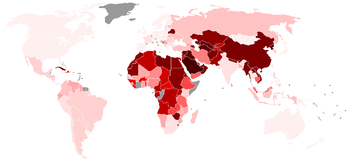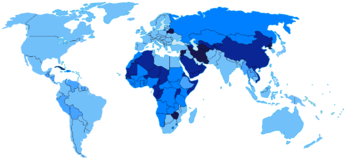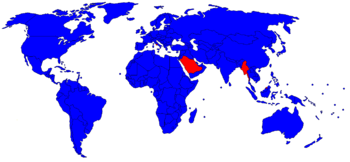DEMOCRACY---CIVICS FORM TWO.
INTRODUCTION.
A democracy (a word from the Greek language, demokratia meaning rule by the people[1]) is a kind of government. A democracy is a system where people are able to decide how their country or community should be run.
The most common type of democracy is representative democracy, where people elect their leaders (normally by holding an election) who decide the laws.[2] Elections are usually held every few years. When they happen, whoever gets the most votes will end up with the most power, until the next election.
An important part of representative democracy is political parties. Politicians belong to a political party, an organisation of politicians with similar ideas on what to do. Therefore, in elections, people just do not vote for a single person but for political parties.
To become a stable democracy, a state usually undergoes a process of democratic consolidation.




In direct democracies, everyone has the right to make laws together. One modern example of direct democracy is a referendum, which is the name for the kind of way to pass a law where everyone in the community votes on it. Direct democracies are not usually used to run countries, because it is hard to get millions of people to get together all the time to make laws and other decisions. There is not enough time.
In an indirect, or representative democracy, people choose representatives to make laws for them. These people can be mayors, councilmen, members of Parliament, or other government officials. This is a much more common kind of democracy. Large communities like cities and countries use this method, but it may not be needed for a small group.
However, only a few people could actually join in. Parliament was chosen by only a few percent of the people (in 1780, less than 3% of people joined in).[5] The ruler also had the power to call parliaments. After a long time, the power of Parliament began to grow. After the Glorious Revolution in 1688, the English Bill of Rights made Parliament more powerful.[5] Later, the ruler became a symbol instead of having real power.[6]
The most common type of democracy is representative democracy, where people elect their leaders (normally by holding an election) who decide the laws.[2] Elections are usually held every few years. When they happen, whoever gets the most votes will end up with the most power, until the next election.
An important part of representative democracy is political parties. Politicians belong to a political party, an organisation of politicians with similar ideas on what to do. Therefore, in elections, people just do not vote for a single person but for political parties.
To become a stable democracy, a state usually undergoes a process of democratic consolidation.

This map shows the findings of Freedom House's survey Freedom in the World
2013. The survey reports how much freedom countries had. Just because
countries are the same color does not mean they are exactly the same.[3] Free (90) Freedom House considers these to be liberal democracies.[4] Partly Free (58) Not Free (47)

The Polity IV data series
is another way of measuring how democratic countries are. This map
dates from 2003. The lighter the country, the more democratic it is.

Democracy Index as published in January, 2007. The lighter the country, the more democratic it is.

Since World War II, countries have accepted the idea of democracy. This
map shows which countries that call themselves democracies. The
countries that do not are Saudi Arabia and Myanmar, as well as the extremely small countries of Brunei and Vatican City Governments who see themselves as a democracy Governments who do not see themselves as a democracy
Contents
Kinds of democracy
There are two kinds of democracy: Direct and indirect.In direct democracies, everyone has the right to make laws together. One modern example of direct democracy is a referendum, which is the name for the kind of way to pass a law where everyone in the community votes on it. Direct democracies are not usually used to run countries, because it is hard to get millions of people to get together all the time to make laws and other decisions. There is not enough time.
In an indirect, or representative democracy, people choose representatives to make laws for them. These people can be mayors, councilmen, members of Parliament, or other government officials. This is a much more common kind of democracy. Large communities like cities and countries use this method, but it may not be needed for a small group.
Examples
Examples of democratic states are Turkey, Sweden, Finland, Canada, Norway, South Africa, India, Brazil and Australia.History
Ancient origins
This kind of government was developed long ago by the ancient Greeks in the city of Athens. They had everyone who was a citizen (slaves, women, foreigners, and children could not vote) got together in one area. The Assembly would talk about what kinds of laws they wanted and voted on them. The Council would suggest the laws. In the Assembly, the participants are only the citizens. In the Council, they would pick them by draws(lot). The participants in the Council would change every year and the amount of people in the Council is at the most 500. The Greek citizens would pick a leader by writing the name of their favorite candidate on a piece of stone or wood. The person with the most votes became the leader.Middle Ages
In the Middle Ages, there were many systems in which there were elections or assemblies, although only a few people could join in at this time. The Parliament of England began from the Magna Carta, a document which showed that the King's power was limited, and protected certain rights of the people. The first elected parliament was De Montfort's Parliament in England in 1265.However, only a few people could actually join in. Parliament was chosen by only a few percent of the people (in 1780, less than 3% of people joined in).[5] The ruler also had the power to call parliaments. After a long time, the power of Parliament began to grow. After the Glorious Revolution in 1688, the English Bill of Rights made Parliament more powerful.[5] Later, the ruler became a symbol instead of having real power.[6]
Other
- Majority rule
- Direct democracy
- Democratic consolidation
- Political party
- Constitution
- Constitutional economics
- Political economy
- Election
- Rule of law
- Citizenship
- Activism
- Politics
References
- "BBC - h2g2 - Demokratia - the Athenian Democracy". bbc.co.uk. Retrieved 13 July 2010.
- "Democracy Conference". Innertemple.org.uk.
- Freedom in the World 2013
- freedomhouse.org: Methodology Archived 3 February 2011 at WebCite
- "Exhibitions & Learning online | Citizenship | Struggle for democracy". The National Archives. Retrieved 2010-08-22.
- "Exhibitions & Learning online | Citizenship | Rise of Parliament". The National Archives. Retrieved 2010-08-22.
No comments:
Post a Comment